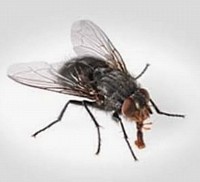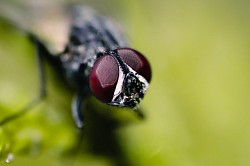Insect facts
Flies
It's that time of the year, flies everywhere!!!! Arriving unannounced on your doorstep during dinnertime. Once flies see that window of opportunity, they come flying right in. You can ‘shoo’ the flie all you want, but chances are, already done the deed all over your meal.
Fly facts
1.House flies live on a liquid diet. A house fly will regurgitate digestive juices onto solid foods and these juices break down the food into small pieces, allowing them to use their mouthparts, called proboscis, to drink the meal.
2. They can taste with their feet. Flies can taste food using their feet!This is all down to taste receptors being located on their lower legs and feet. When a fly lands on a tasty meal, which can be anything from animal feces to your lunch, they will often wander around to give their next meal a good taste before consuming it.
3. House flies defecate… a LOT. As you know, house flies like to live off a liquid diet. Because of this, their digestive system can move quite quickly, which means they defecate often. It is speculated that house flies defecate every time they land, even if it’s on their next meal!
4. They can spread a range of diseases. Due to their feeding and breeding habits house flies come into contact with a range of harmful bacteria such as Salmonella and E.coli. Because of this, house flies will often aid the spread of these bacteria passing them onto us by contaminating things, such as food and cooking utensils.
5. House flies can walk upside down. The anatomy of a house fly enables it to walk and climb on most surfaces no matter if it’s horizontal, vertical, or even upside down. This is due to each foot containing two fat foot pads which contain tiny hairs that produce a glue-like substance made of sugars and oils which provides them with excellent grip, perfect for scaling any surface.
6. Flies are able to see behind them. That’s right, house flies can see behind them and it’s all to do with their amazing eyes.
7. The lifespan of a house fly isn’t that long On average, the life cycle of a house fly only lasts for around 30 days. House flies can lay up to 500 eggs in their lifetime which are usually in batches of around 75 to 150. So, although they don’t live long, an infestation can quickly arise through new generations.
8. House flies have amazing reaction times. House flies are able to process what they see and react accordingly at amazing speeds. To put things into perspective, our brains process around 60 images a second, whereas a fly can process around 250 in a single second.
9. They have unhygienic breeding habits. House flies will lay their eggs on items such as feces, rotting carcasses, and decaying fruit. Why is this? Well, it’s mainly to provide the larvae (maggots) with something to eat when they hatch.
10. Male house flies are constantly looking for a date.
Studies show that there’s a specific region within the eyes of a male fly called the "love spot." It is pretty much used for detecting and chasing female
InsectPro can get rid of all flies Species.
Cockroach
Most homeowners are aware of the health and safety risks associated with cockroach infestations, including the allergies and asthma triggered by cockroach allergens, and the germs and bacteria they have been known to spread. What may not be as widely known is the fact that cockroaches are a very interesting and resilient pest that exhibits some very odd behavior and survival tactics. For example, cockroaches spend 75% of their time resting and can withstand temperatures as cold as 0 degrees.
Cockroach facts
1.) A Cockroach Can Live for Week Without Its Head
2.) A Cockroach Can Hold Its Breath for 40 Minutes
3.) They Can Run Up to 4.8 km in an Hour
4.) Newborn German Cockroaches Become Adults in as Little as 36 Days
5.) Cockroaches are cannibals
6.) Cockroaches enjoy a nice, cold beer now and then.
7.) The World's Largest Roach is 15,24cm Long
8.) Cockroaches are Really Old 280 million years
9.) There are More Than 4,000 Different Cockroach Species Worldwide
10.) Cockroaches Can Live Without Food for One Month
Cockroach facts.
11.There are bacteria that live in roaches & help them survive.
12. Cockroaches can, and will, eat anything.
13.They don’t need their heads.
14. There are bacteria that live in roaches & help them survive.
15. Cockroach egg can have around 12 young in every egg case, a female and her offspring can produce 800 additional cockroaches in just a single year





